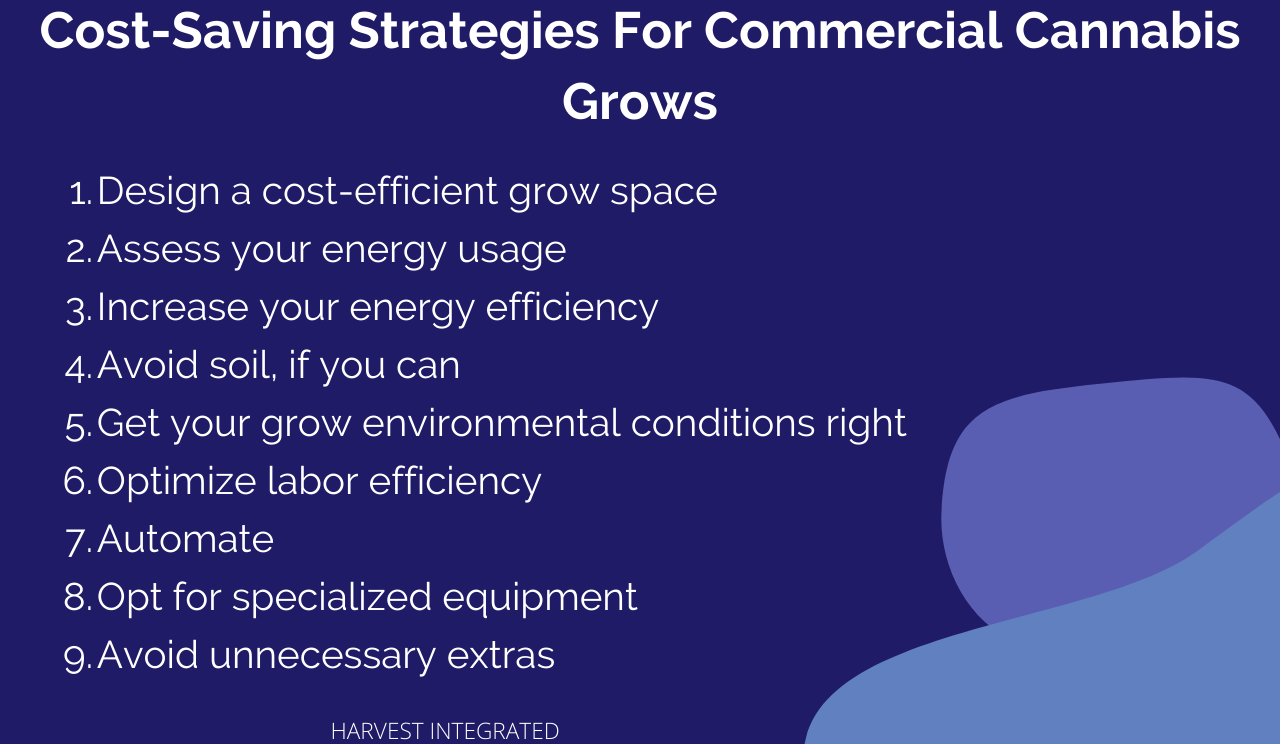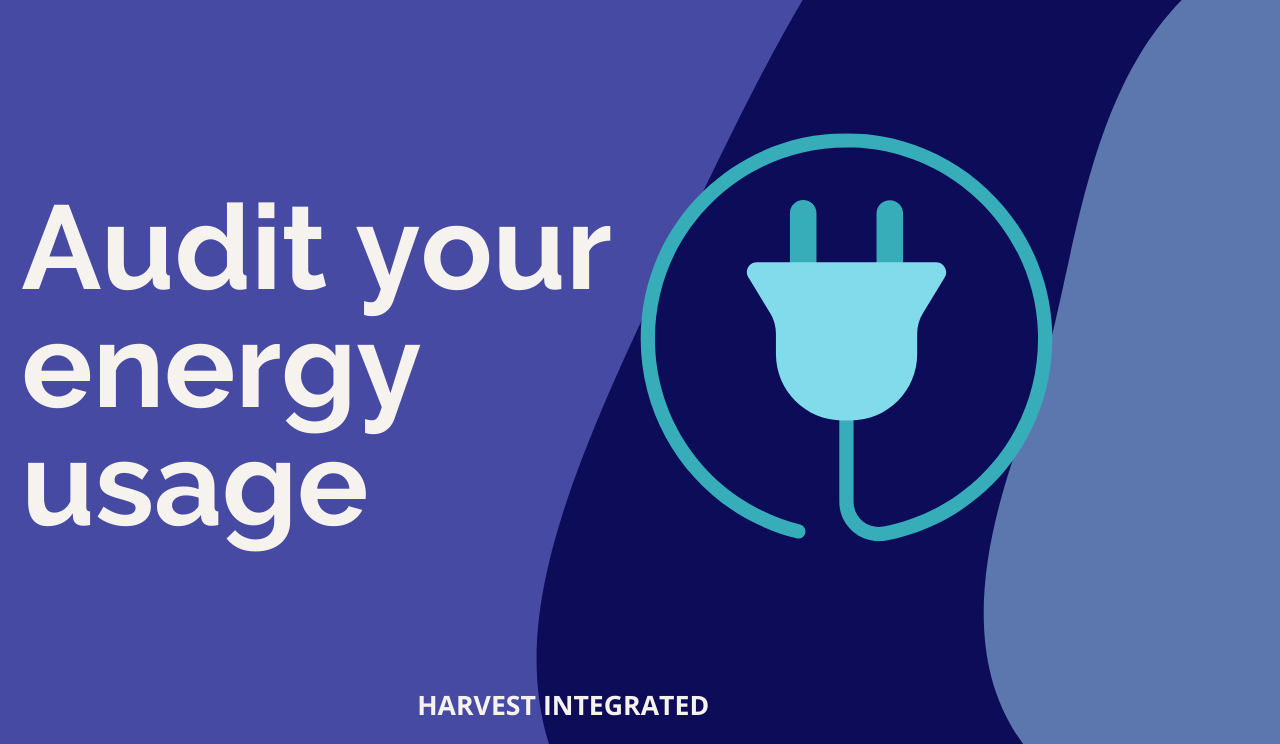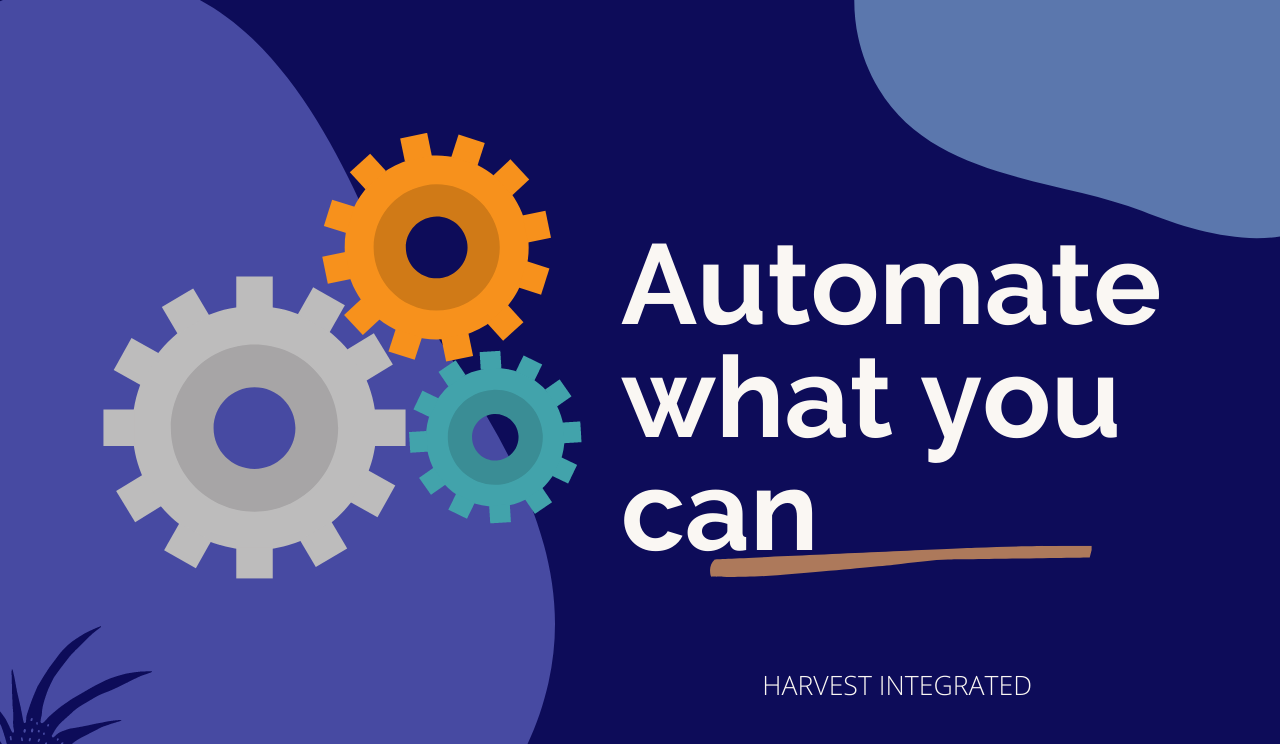Growing cannabis on a commercial scale is expensive, particularly in grow rooms. The typical commercial grow room setup costs average $75 per square foot. Total setup costs can stretch into millions and monthly operating costs can easily run into the high six figures.
Additionally, commercial cannabis cultivation has some tight margins, and running a profitable operation requires lots of work. Throw in the fierce competition in the industry and you can see that robust business policies are a must-have. Without said policies, failure is imminent.
As highlighted in this Cannabis Production Outlook Guide for 2022, cutting costs is essential for survival in the volatile and rather complex cannabis industry. In light of this, here are nine cost-saving strategies to help you get started.

1. Design a cost-efficient grow space
It’s one thing to run a 500 square foot grow and quite another to manage a 50,000 square foot facility. The bigger a grow, the bigger the stakes, and the more essential it is to design your facility with cost efficiency in mind.
Some things to remember when designing a commercial grow space:
- Use materials that are easy to clean and maintain otherwise you may end up spending too much on maintenance.
- Opt for a location with a favorable climate so that you minimize the amount of resources you spend on your facility’s environmental control.
- Think about accessibility. Your grow space should be in a good location – an area that’s easily accessible but not too populated to pose security risks.
Accessibility is also important when it comes to resources such as energy and water. If these two are not easily accessible you may end up losing a lot of money.
2. Assess your energy use

High energy consumption is a huge contributor to cannabis grow operation bills, so what better way to cut said bills than by finding ways to reduce the energy consumption.
However, you can only reduce energy consumption if you know what’s causing it. This is where energy audits come in.
Measure power usage in your grow room, or better yet, get a team of professionals to do it for you. Many energy companies offer free energy audits for businesses, including those in the cannabis industry.
3. Increase your energy efficiency
Once you have audited your energy use, it’s time to increase your energy efficiency.
Increasing energy efficiency is critical to a commercial grow facility’s success since it’s one sure way of reducing operational costs. Unfortunately, grow facilities are notorious for energy inefficiency.
Consider this. A 5,000 square foot indoor farm in Colorado was using 41,808 kilowatt-hours per month, according to 2015 research findings from the National Coalition of State Legislatures. On the other hand, an average household in the same state was using roughly 630 kilowatt-hours.
That’s a whopping 6536% difference!
Achieving a high level of efficiency can be the differentiator between failure and a successful, sustainable grow. But how do you go about it?

Look at your light cycle
Cannabis is a short-day plant. It moves from the vegetative growth stage to the flowering stage when light exposure is reduced to 12 hours. As such, you can manipulate lighting to your advantage. Not only will adjusting your light cycle make it easier to reduce energy consumption, but it will also shorten cropping times and allow for more cultivation cycles.
Operate lighting during non-peak hours
A lot of municipalities have different energy rates for peak and non-peak hours.
Operating grow lighting during peak hours can translate into a bigger utility bill as energy costs are higher. Conversely, operating the lights during non-peak hours can offset some of the energy costs.
Something as simple as switching your lighting schedule to align with the non-peak hours when energy is much cheaper can result in substantial cost savings.
Choose the correct lights
A lot of cannabis growers overwhelmingly turn to high-pressure sodium (HPS) lights for their lighting needs. But HPS lights are not very energy-efficient and they result in higher energy consumption and costs. Although double-ended HPS bulbs have better light output compared to single-ended HPS bulbs, the bottom line is that HPS bulbs are a huge power suck.
Switching to power-saving solutions like semi or fully automated LED grow lights is a good way to reduce costs. In fact, LED lights use between 40-75% less energy than HPS lights. LED fixtures also have more benefits, for example, they:
- Have superior light quality and growers can adjust them to suit specific plants’ needs.
- Are more energy efficient compared to the other commercially available lighting technologies. There are several reasons for the higher efficiency including the fact that they emit lower heat and waste very little energy.
- Boast of a very long lifespan compared to other lighting technology. New LEDs can last up to 100,000 hours or more. By comparison, a fluorescent bulb will last roughly 10,000 hours.
- Are easy to maintain and have very low maintenance costs.
The up-front cost of LED lighting tends to be the biggest downside for many growers. However, the long-term cost-savings that growers can achieve with LEDs usually far exceed the initial costs.
Replace the lights according to the manufacturer’s recommendations
Choosing the right lights is important, but so is knowing when it’s time for some replacement.
As bulbs age (even LEDs), they are usually less effective at emitting light – but they will still be consuming the same amount of energy as before. It may seem like a good idea to use lights past the recommended time, but this can lead to inefficiencies and higher energy consumption, which will increase your energy bill.
Avoid wasting light
The point of having grow lighting in the grow room is to aid plant development. So every time your grow lights strike anything other than the plant canopy, energy is probably being wasted.
Light striking the walls instead of the plants? Waste.
Light striking off the floors instead of the plants? Waste.
Plants will only use the light that directly strikes the plant canopy. Therefore, you can save energy and cut your bills by ensuring that no light gets wasted in the grow room.
Keep things clean
Dirty equipment can be costly. For example, if reflectors are dirty, light will not bounce off them (the reflectors will absorb the light instead). This means that the light won’t get to its intended destination (the plants). Put simply, avoid dirt because it can be a big source of energy waste and unnecessary costs.
Service equipment regularly
If you don’t maintain your equipment, suboptimal performance, energy inefficiency, and high energy costs are inevitable. This is particularly true for large equipment such as HVAC, which contributes significantly to a grow room’s total energy consumption.
Consider the cannabis strain you opt for
Your choice of cannabis strain may help you cut costs. While certain strains may require 18 hours of light during the vegetative stage of growth, others may only need 16 hours of light. The reduced light requirement can result in some cost savings.
Get your insulation right
A grow facility’s HVAC uses a lot of energy, more so when the facility is not well insulated. Poor insulation means the HVAC system has to work overtime; this results in higher energy usage and increases costs.
By ensuring that your grow has good insulation, your HVAC doesn’t work more than it needs to and you get to save energy and money.
Leverage renewables
Renewables were the cheapest energy source in 2020. According to the International Renewable Energy Agency (IRENA), 62% of renewables that came on stream in 2020 were cheaper than the cheapest fossil fuel.
Powering commercial cannabis facilities solely on renewables may not be feasible for many growers right now. Cannabis requires lots of energy and the amount of solar needed to make a difference in commercial grows is often simply unattainable. Nonetheless, leveraging renewables for some parts of the growing can contribute to smaller energy bills.
Additionally, leveraging renewable energy sources and promoting sustainability is now more important than ever as we grapple with the effects of climate change.
Related Reading: Cannabis and the Environment: The Impact and What You Can Do About It | How To Create A Sustainable Cannabis Grow Facility
4. Avoid soil if you can

Soil is a good growing medium, but it can easily inflate your costs when you’re cultivating cannabis in a grow room. Costs can quickly add up when you factor in things such as the cost of transporting the soil or disposing it. Soil can also be costly since it can bring harmful pests and parasites into an otherwise contaminant-free grow room.
Hydroponics are a good alternative to growing in soil.
Although they are a bit more expensive to set up compared to soil, you can cut costs once you are cultivating. Water is usually the biggest cost after setup, but you can reduce the cost by purifying and reusing the water.
And hydroponics have some serious benefits. For example, since they are very efficient at providing nutrients, hydroponics make plants develop faster than plants grown in soil and they tend to result in larger yields. Plus, you reduce or even eliminate the risk of soil-borne diseases.
5. Get your grow environmental conditions right
Optimizing your grow’s environment is a sound cost-saving strategy. Replicating the outside climate conditions with precision means your climate control system doesn’t have to work so hard and you get to cut energy consumption.
Achieving the optimal environment for your crop will hinge on how well you can control the main elements of CEA environmental control – humidity, airflow, temperature and light.
Related Content: Understanding HVAC: Key HVAC Terms
6. Invest in labor efficiency optimization
An efficient labor force saves money. This is true for labor in the cannabis industry as well.
The following are some tips for optimizing labor efficiency.
- Develop robust work policies and standard operating procedures. This way, everyone knows what they are expected to do, how they will do it, and who they will ask for assistance and report to.
- Have regular open conversations about what workers need to do. Policies and procedures need to be supported by regular check-ins to ensure that tasks are moving smoothly.
- Equip workers with all the tools they need and make sure the tools are easily accessible so that they are not constantly wasting time searching for things. Likewise, it’s important to provide workers with all the training they need to perform their duties well.
- Create a robust workflow that highlights scheduled tasks and daily operations. The workflow should be easy for all team members to follow.
- Track and analyze performance. The performance analysis will help determine where workers require assistance to improve their work and productivity.
7. Invest in automation technology

Machines will probably not fully replace human labor soon, but they can make it easier to cut costs in cannabis production, provided that everything is properly set up and managed.
What can you automate in a cannabis grow? Several things including:
- Lighting
- Climate control (e.g. temperature control) and environmental monitoring
- Plant transplanting and moving plants
- Fertigation
- Irrigation
- Trimming
Being able to monitor the grow environment, reduce unnecessary inputs, and automatically track cultivation activities in real-time will help reduce your labor needs and continually improve your business processes. More efficient processes will, in turn, help you eliminate some operating costs.
Related Content: How Grow Room Automation Can Promote Sustainability | The Ultimate Guide To Grow Room Controllers
8. Opt for specialized equipment
Conventional equipment may work, but it’s not necessarily the most efficient, both in terms of performance and cost savings. Having the right equipment could easily cut electricity bills.
Specialized equipment for cannabis grows has variable settings that will help you save on power consumption as well as prevent plant shock. With variable settings, you can control the equipment’s voltage, plus you can easily adjust power and intensity. Some applications of variable settings include those for dimmable LED lights and circulation exhaust fans.
Granted, specialized equipment may cost more initially, but it will result in higher cost-savings in the long run.
9. Don’t go overboard with the extras
Not every extra will be worth having in your grow room. You can save some money by not wasting on unnecessary extras for otherwise already healthy plants.
Do you really need the CO2 supplementation or you’re just doing it because other growers are using carbon dioxide in their grows?
Do you need certain brand-name nutrients when there are cheaper alternatives that are just as good?
It’s possible to save tens of thousands of dollars by switching to lesser-known nutrient brands that still get the work done.
The beauty of cannabis is that it rarely requires any special supplements to get an outstanding bud. You’re better off focusing on the strain type and grow environment control – two things that have an impact on how the crop turns out.
Pesticides are another extra you can reduce to cut costs without affecting your crop. They can potentially contribute to a sizable chunk of a grow’s bills, but there are ways to reduce their use.
One relatively straightforward way to do this is to keep things clean. A clean grow room with clean equipment will go a long way in eliminating the spread of pests, pathogens, and infectants such as powdery mildew. Similarly, clean air in a grow room will help prevent mold, pest and pathogen breakouts. Even if these occur, clean air will minimize the impact.
You can also cut pesticide use by isolating the air supply in each room. This will eliminate shared air and keep pests and pathogens from spreading.
When it comes to any extras, it’s important to stop splurging on things that are not fundamental for the plants’ growth and development. Such things will only serve to eat into your profit margins and business success.
Implementing cost-saving strategies for commercial cannabis grows
Cutting costs increases profits.
Ultimately, you have nothing to lose and everything to gain by reducing costs in your commercial cannabis grow, so why not give these strategies a try?
Looking to gain more understanding on grow facility costs? Be sure to check out our piece on HVAC System Cost – What You Need to Know About the Cost of Grow Room HVAC Systems.